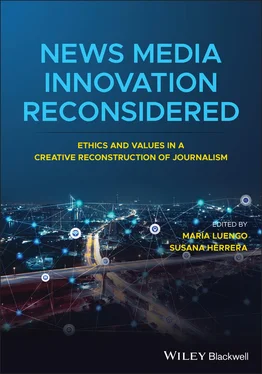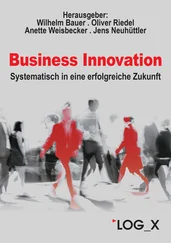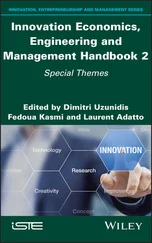5 Breese, E.B. and Luengo, M. (2016). Conclusion: news innovations and enduring commitments. In Alexander, J.C., Breese, E.B., and Luengo, M. (Eds.). The Crisis of Journalism Reconsidered: Democratic Culture, Professional Codes, Digital Future. Cambridge/New York: Cambridge University Press, pp. 282–289.
6 Bruno, N. and Nielsen, R. (2012). Survival Is Success: Journalistic Online Start-Ups in Western Europe. Oxford: Reuters Institute for the Study of Journalism, University of Oxford.
7 Carlson, M. (2016). Telling the crisis story of journalism: narratives of normative reassurance in Page One. In Alexander, J.C., Breese, E.B., and Luengo, M. (Eds.). The Crisis of Journalism Reconsidered: Democratic Culture, Professional Codes, Digital Future. Cambridge/New York: Cambridge University Press, pp. 135–152.
8 García-Avilés, J.A. (2016). Developing an index of media innovation in a national market, journalism studies, Journalism Studies, 9(1) 1–18. http://dx.doi.org/10.1080/1461670X.2016.1161496
9 Jones, S. (2017). Disrupting the narrative: immersive journalism in virtual reality. Journal of Media Practice, 18(2–3), 171–185. https://doi.org/10.1080/14682753.2017.1374677
10 Kukkakorpi, M. and Pantti, M. (2020). A Sense of Place: VR Journalism and Emotional Engagement. https://doi.org/10.1080/17512786.2020.1799237
11 Luengo, M. (2016). When codes collide: journalists push back against digital desecration. In Alexander, J.C., Breese, E.B., and Luengo, M. (Eds.). The Crisis of Journalism Reconsidered: Democratic Culture, Professional Codes, Digital Future. Cambridge/New York: Cambridge University Press, pp. 119–134.
12 McBride, K. and Rosenstiel, T. (Eds.). (2014). The New Ethics of Journalism. London: Sage.
13 Nee, R.C. (2013). Creative destruction: an exploratory study of how digitally native news nonprofits are innovating online journalism practices. International Journal on Media Management 15(1), 3–22.
14 Negredo, S., Martínez-Costa, M.P., Breiner, J., and Salaverría, R. (2020). Journalism expands in spite of the crisis: digital-native news media in Spain. Media and Communication, 8(2), 73–85.
15 PA Media Group (2018). https://pamediagroup.com/more-than-1000-uk-regional-news-titles-now-have-access-to-stories-jointly-written-by-journalists-and-ai-as-radar-launches-new-website
16 Padioleau, J.-G. (2006). Les médias face à la destruction créatrice. Débat, 139, 109–121.
17 Revers, M. (2016). Digital media and the diversification of professionalism: a US-German comparison of journalism cultures. In Alexander, J.C., Breese, E.B., and Luengo, M. (Eds.). The Crisis of Journalism Reconsidered: Democratic Culture, Professional Codes, Digital Future. Cambridge/New York: Cambridge University Press, pp. 228–246.
18 Schlesinger, P. and Doyle, G. (2014). From organizational crisis to multi-platform salvation? Creative destruction and the recomposition of news media. Journalism, 16(3), 305–323. https://doi.org/10.1177/1464884914530223
19 Schumpeter, J.A. (1975 [1942]). Capitalism, Socialism and Democracy. New York: Harper & Row.
20 Waterson, J. (2020). Microsoft sacks journalists to replace them with robots. The Guardian (30 May).
Journalism, Ethics, and Innovation in Times of Digital Turbulence
1 An Inquiry into the Ethics of Innovation in Digital Journalism
José Alberto García-Avilés
Universidad Miguel Hernández
An Ethical Perspective on Journalism Innovation
Research into the evolution of journalism ethics from the perspective of innovation offers wonderful insights. Throughout the past decades, journalists have embraced the innovations implemented in many newsrooms and, at the same time, they have met the ethical challenges brought about by these innovations. In this process, we could establish a pattern. Initially, journalists tend to regard the new practices as a challenge to the established standards, that is, as something alien to the shared ethical guidelines and therefore, they tend to believe these new practices should be questioned on ethical grounds. This attitude often translated into a veiled rejection of those innovations that at first sight seemed to collide with the traditional professional practices. However, as the innovations gradually take hold in the newsrooms and the journalists accept them, ethical standards are adapted accordingly to this new reality.
In the digital media ecosystem, the boundaries between producers, audiences, content, technology, and business tend to fade away as the platforms and algorithms increasingly gather and distribute information through multiple channels, with a massive offering of news and entertainment that is seamlessly integrated into people’s lives (Ruotsalainen and Heinonen, 2015). Traditional sources of income based on advertising show symptoms of fatigue, and the competition between legacy media and digital pure players increases, as the business strategies that worked for decades have become obsolete (Küng, 2017).
After several stages of adaptation and integration into this digital ecosystem, the media are living up to constant change. However, what is new is not change itself but the pace and the degree of change in journalism: a constant and deep transformation accelerated by the simultaneous impact of different technologies (virtual reality, artificial intelligence, blockchain, voice, data mining, etc.) in the gathering, production, distribution, and commercialization of content. In addition, technological companies have burst into force, competing with the news outlets for users’ attention. These powerful players (Google, Apple, Facebook, Amazon, etc.) monopolize a large percentage of advertising investment, as well as many successful live streaming platforms (Netflix, HBO, Disney+, Amazon Prime, Spotify, etc.).
In this complex scenario, aggravated by the worldwide crisis of COVID-19, the media have less control over how and where their contents are consumed, while their relationship with audiences is weakened by a more interactive, horizontal, and collaborative communication. On the other hand, digital-only media have been able to fully understand the mobile, social, and global ecosystem and, what is more important, they have rapidly adapted to the consumption habits of hyperconnected users. Therefore, when facing disruptive competition, legacy media companies need to focus their strategies on sustainability, market penetration, and innovation.
In this context, media innovation has been invoked as a “mantra,” which offers a solution to the complex industry problems. However, innovation advocates often lack a clear conceptual background about how innovations are differentiated from change, when exactly is something considered to be innovative, and at what level of analysis (individual, organizational, product, or process) does innovation lie (Prenger and Deuze, 2017). As both authors argue (p. 235), “epistemological challenges further amplify these wide-ranging questions, as innovation is invariably a moving object, raising the issue of how to adequately study something so dynamic.”
Any kind of innovative journalism should also be an ethical one. Without the essential component of ethics, no journalism is capable of innovating because the very professional activity of reporting itself is based on the commitment to the truth. Accordingly, journalistic ethics and quality are synonymous terms since all quality journalism is necessarily ethical. In Tony Harcup’s words, “ethical journalism is crucial for the health and well-being of a society” (2006, p. 144).
Journalism ethics is the result of multiple and complementary forces. Ethical reasoning is a unique and indivisible reality, which is individually, institutionally, and culturally based. Professional ethics cannot be isolated from individual or social ethics. When news organizations face ethical quandaries, they often implement regulations, norms, and codes that soon tend to become obsolete (Whitehouse, 2010).
Читать дальше












